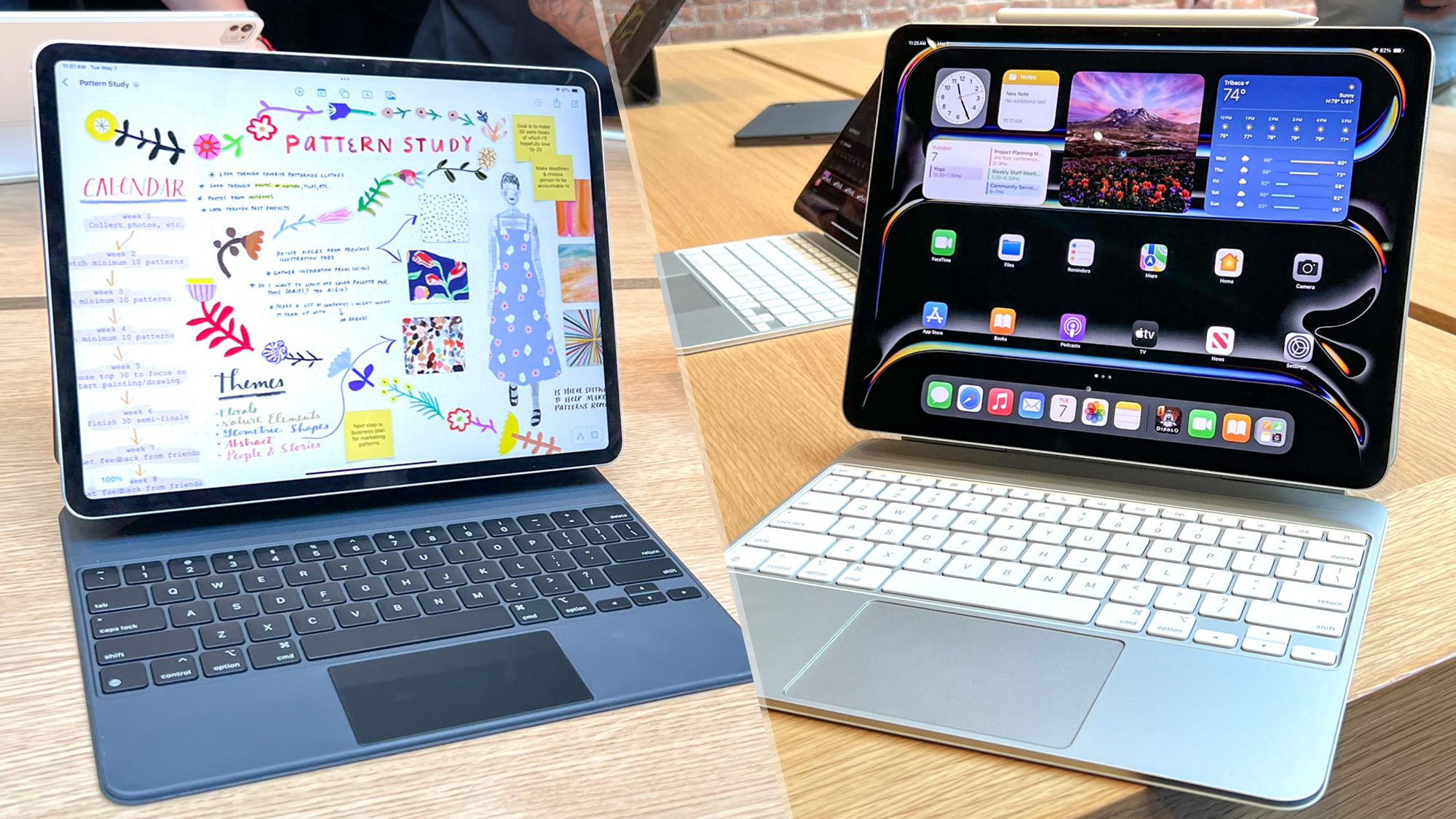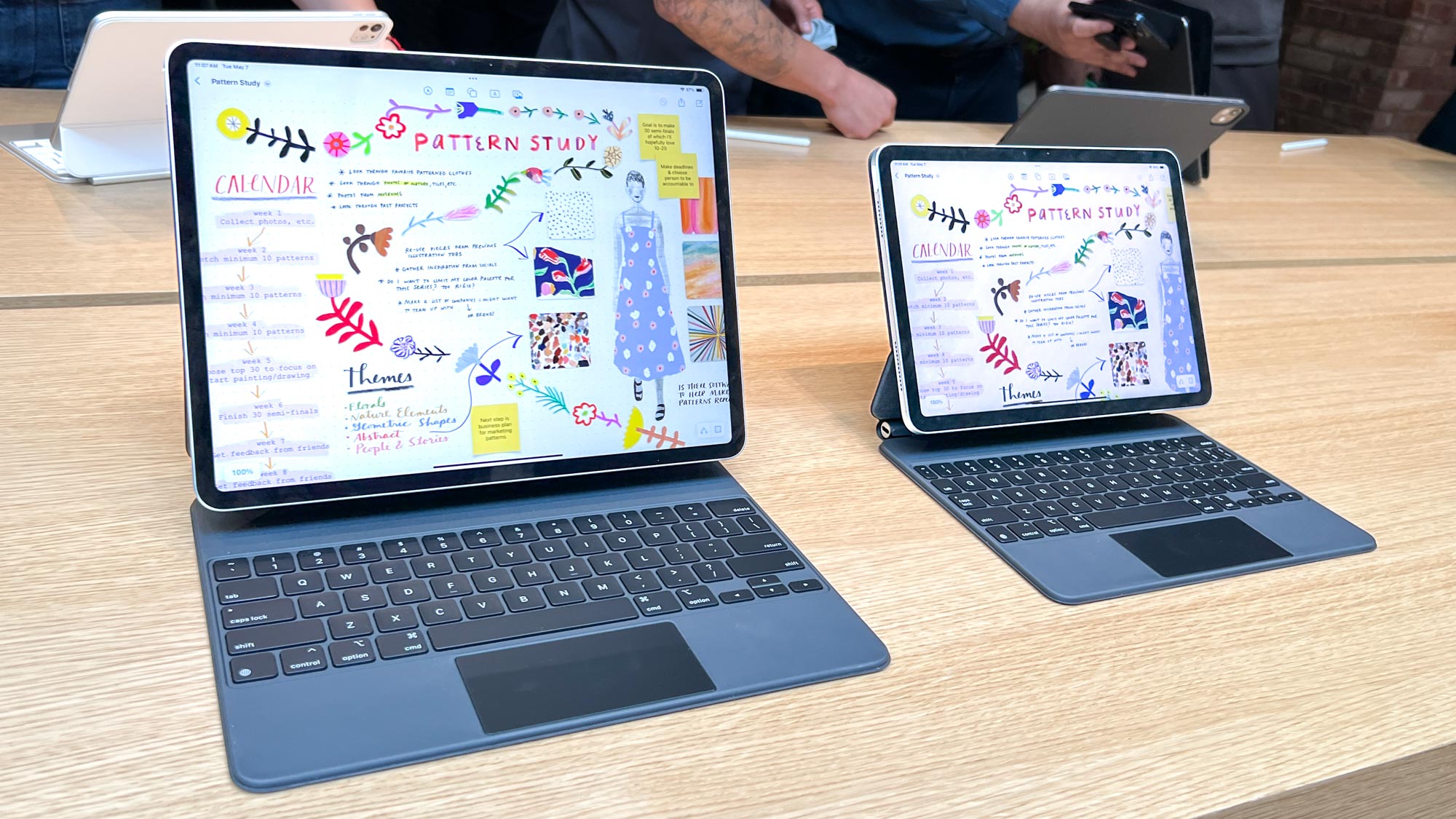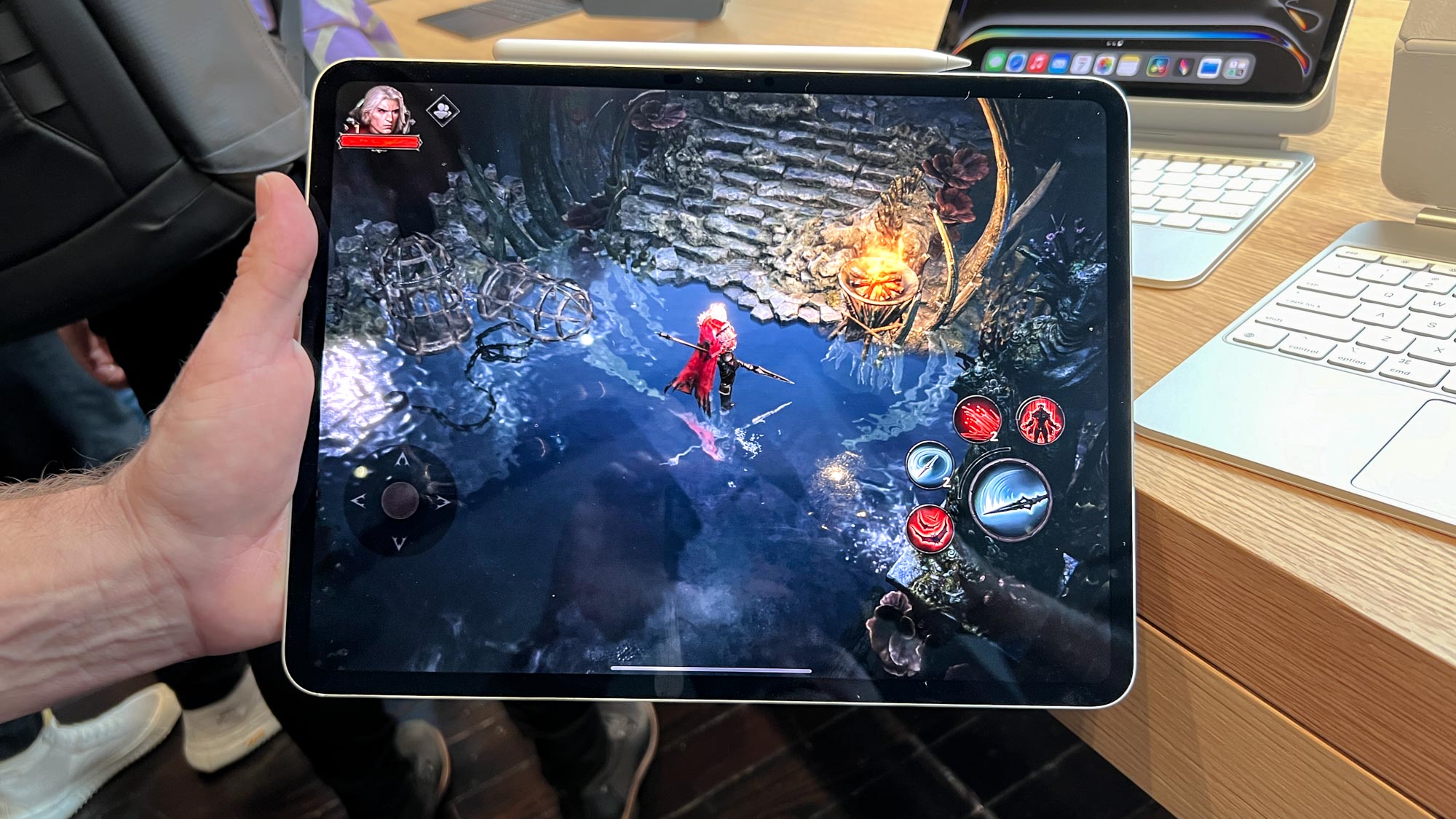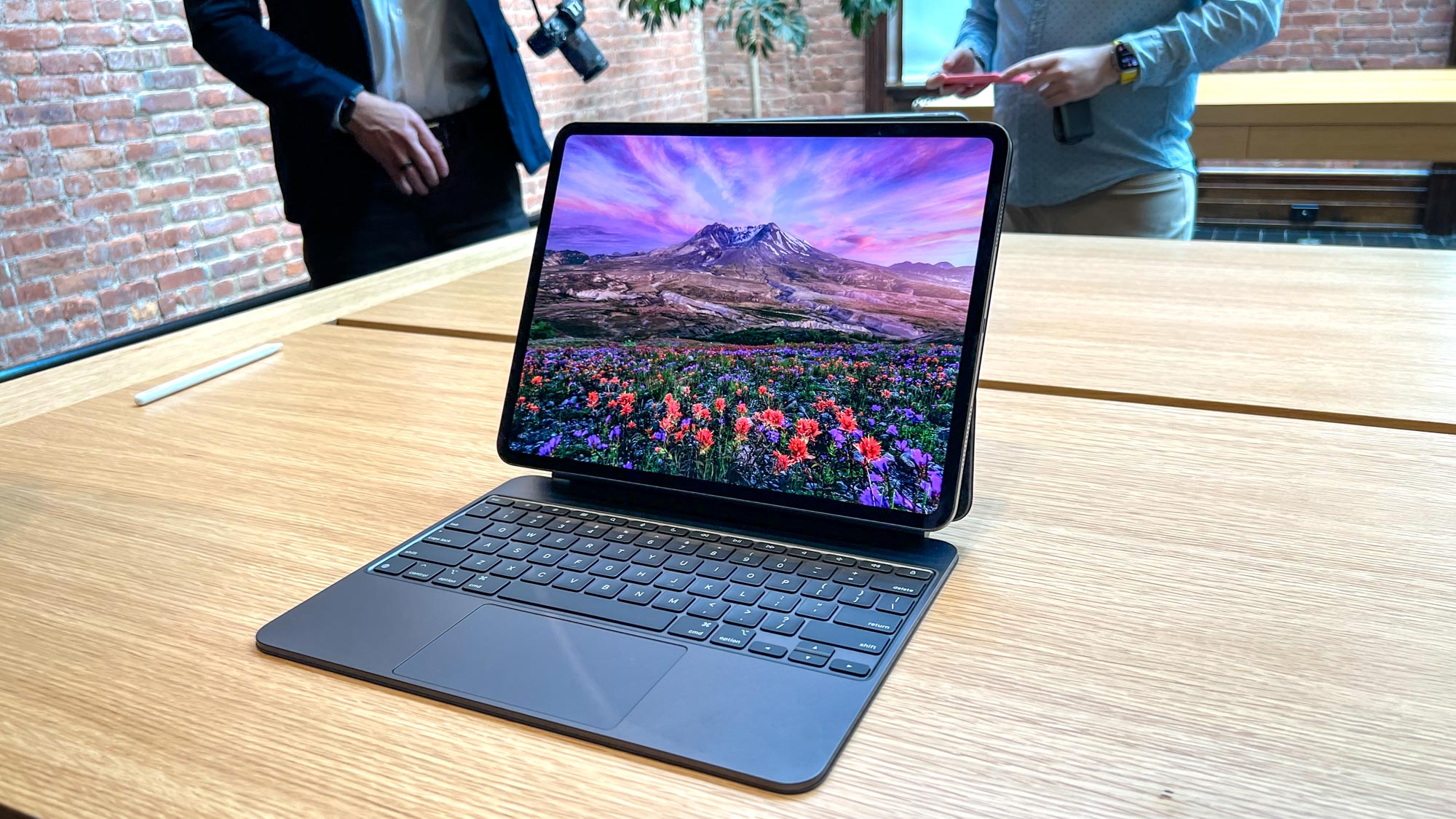iPad Pro 2024 benchmarks: Here’s how Apple’s M4 chip performs
We've tested Apple's latest tablets, and the M4 drives the iPad Pro 2024 to new heights

Apple is launching two new iPads this Wednesday (May 15), and we've had the chance to test them first.
This is a big deal because one of these slates, the iPad Pro 2024, is the first device to hit the market with the Apple M4 chip inside. Now that we've had a chance to put it through its paces in our testing lab, I can tell you with confidence that it's the fastest and most powerful tablet we've ever tested.
That—along with the new OLED display—helps justify the fact that Apple raised the price of an entry-level iPad Pro by $200, so it now costs at least $999 to take one home. If that's more than you'd care to spend on a tablet, Apple is also launching the new iPad Air 2024 this week sporting the Apple M2 chip.
The new Air starts at just $599, and based on our lab testing it's nearly as fast as the Pro despite costing almost half as much. While the Pro is the clear winner in terms of speed and battery life, both the new iPad Air 2024 and the iPad Pro 2024 have proven themselves to be fast, power-efficient slates that outperform any other tablet we've recently tested. Factor in the comforts of iPadOS and the Apple App Store, and you start to see why I think they're some of the best tablets you can buy right now.
In fact, they're so fast and capable that they easily speed past some of the best budget laptops on the market, which is to be expected given even the cheapest of these new iPads cost more than a great budget laptop like the $299 Acer Aspire Go 15. Still, it's nice to know that when you consider the iPad Pro could be a legitimate laptop replacement with the right gear.
But enough preamble, let's jump right into our test results so I can show you how well these new iPads perform under pressure.
These are the fastest iPads yet

| Row 0 - Cell 0 | Geekbench 6.3 single-core | Geekbench 6.3 multi-core | CrossMark (Overall) |
| iPad Pro 2024 (M4) | 3692 | 14512 | 1915 |
| iPad Air 2024 (M2) | 2594 | 10088 | 1441 |
| Google Pixel Tablet (Tensor G2) | 1419 | 3563 | 925 |
| Lenovo Tab Extreme (MediaTek Dimensity 9000) | 1625 | 4280 | 959 |
| Samsung Galaxy Tab S9 Ultra (Snapdragon 8) | 2009 | 5206 | 1292 |
| OnePlus Pad (MediaTek Dimensity 9000) | 1079 | 3366 | 925 |
As you can see from the table of test results above, the 2024 iPad Pro and iPad Air are the fastest tablets we've tested yet, blowing away competitors from Lenovo, Google and Samsung.
Sign up to get the BEST of Tom's Guide direct to your inbox.
Get instant access to breaking news, the hottest reviews, great deals and helpful tips.
Before I dive in and start explaining why, let me quickly warn you about something: There are two power levels of iPad Pro 2024, and which one you get depends on which model you buy.
The only way to get the most powerful iPad Pro 2024 is to buy one with 1TB or more of storage, because only those iPad Pro models come with 16GB of RAM built in and a full M4 chip with a 10-core GPU and 10-core CPU.
If you buy an iPad Pro with less than 1 TB of storage, you'll instead get a weaker version that comes with only 8GB of RAM and a 9-core GPU. You likely won't notice the difference while browsing the web, but you might miss having that extra RAM and GPU core when you start opening a lot of apps, streaming video or playing demanding iPad games.
The iPad Pro 2024 Apple sent us for testing comes with 1TB of storage and 16GB of RAM, as well as a full M4 chip with 10-core GPU and CPU. So when looking at our test results, remember this is the high-powered iPad Pro we're testing—so your experience may differ, especially if you buy a cheaper, weaker iPad Pro.
To give you a clear sense of its power I chose to show you the results from our CrossMark and GeekBench 6 tests because they test raw performance. Geekbench gives us two different scores for single-core and multi-core CPU performance, while CrossMark gives us an overall score based on how well the tablet completes a variety of different workloads, from photo and video editing to web browsing.
As you can see, the M4 chip drives the latest iPad Pro to new heights of performance. It's easily the fastest and most capable chip we've ever seen in a tablet, and the scores it put up on Geekbench 6 and CrossMark rival those of even the best laptops on the market.
To show you what I mean, I also charted the new iPad's performance against that of some laptops we've recently tested, including modern gaming laptops like the HP Omen Transcend 14 ($1,499 to start).
| Row 0 - Cell 0 | Geekbench 6 single-core | Geekbench 6 multi-core | CrossMark (Overall) |
| iPad Pro 2024 (M4) | 3692 | 14512 | 1915 |
| iPad Air 2024 (M2) | 2594 | 10088 | 1441 |
| 13-inch MacBook Air (M3) | 3046 | 12057 | 1888 |
| Dell XPS 16 (Intel Core Ultra 7) | 2375 | 13376 | 1799 |
| Asus ROG Zephyrus G14 (gaming) | 2621 | 12302 | 1791 |
| HP Omen Transcend 14 (gaming) | 2367 | 13066 | 1506 |
As the numbers show, the new iPads are awfully fast and the M4 chip helps the iPad Pro 2024 speed past even the MacBook Air 13-inch M3 and the Dell XPS 16, two premium ultraportables that cost as much or more than a new iPad Pro 2024.
Unfortunately, I can't easily show you how much faster these new iPads are compared to their predecessors because we tested the old iPad Air 2022 and iPad Pro 2022 using an older version of Geekbench which isn't directly comparable to the latest version. But rest assured the older models were slower and less powerful than the new 2024 iPads, which also have better battery life than their predecessors—more on that shortly.
They're plenty bright to boot

| Row 0 - Cell 0 | iPad Air 2024 | iPad Pro 2024 |
| Peak brightness (adaptive brightness off) | 572 | 572 |
| Peak brightness (adaptive brightness on) | 568 | 938 |
| Peak brightness (HDR 10%) | 577 | 1516 |
| Peak brightness (HDR 40%) | 577 | 1510 |
| Peak brightness (HDR 100%) | 577 | 957 |
Now that our testing team has had a chance to point some expensive measuring devices at the screens of these new iPads, I can officially tell you they get plenty bright.
Apple has outdone itself with the new iPad Air 2024, as our testing reveals it easily achieves over 500 nits of brightness regardless of whether you're looking at HDR content or if you have the adaptive brightness setting switched on.
That's pretty commendable given that Apple advertises the Air 2024 as sporting a screen capable of achieving 500 nits of brightness, yet in every one of our brightness tests it actually goes a bit beyond that.
Unfortunately I don't have quite the same height of praise for the 12.9-inch iPad Pro 2024 we tested. Don't get me wrong, this beastly machine's OLED screen is gorgeous to look at and more than bright enough, as it gets as bright as the iPad Air 2024 when in SDR mode and can easily get over 1,000 nits of brightness when viewing HDR content.
However, as you can see from our test results above, the iPad Pro 2024's 12.9-inch screen actually falls a bit short of Apple's promised 1,000 nits of brightness in SDR, or 1,600 nits when viewing HDR content.
Don't get me wrong, it gets close enough that most people won't notice. In our testing our iPad Pro 2024 review unit managed to achieve a peak brightness of 938 nits with adaptive brightness turned on, which is better than every tablet save another iPad and quite close to the advertised 1,000.
However, when viewing HDR content on our iPad we saw brightness dip significantly lower than the advertised peak of 1,600 nits. When there was HDR content on just 10% of the screen the iPad Pro 2024 was able to achieve 1,516 nits of brightness, but when we blew the HDR content up to fill 100% of the screen it was only able to achieve a peak brightness of 957 nits.
That's still awfully bright, even if it falls short of the advertised 1,600, so don't get the mistaken impression that movies and shows in HDR won't look good on the new iPad Pro. They should look good and be bright and easy to see, even if the tablet can't quite live up to Apple's promises in our testing lab.
| Row 0 - Cell 0 | sRGB gamut | DCI-P3 gamut | Delta-E |
| Apple iPad Pro 2024 | 117.4% | 83.2% | 0.29 |
| Apple iPad Air 2024 | 110.9% | 78.6% | 0.27 |
| Google Pixel Tablet | 105.4% | 74.7% | 0.05 |
| Microsoft Surface Pro 9 | 106.1% | 75.1% | 0.23 |
| Samsung Galaxy Tab S9 Ultra | 117.7% | 83.4% | 0.17 |
| Apple iPad Pro (2022) | 117.1% | 82.4% | 0.3 |
| Apple iPad Air (2022) | 110.9% | 78.6% | 0.27 |
| Apple iPad (2022) | 101.2% | 71.7% | 0.21 |
We also test every tablet we review to see how well it displays colors, and the new iPads don't disappoint.
You can safely skim over these results if you don't do a lot of work on an iPad that requires color accuracy, like photo and video editing. The important details to note here are that both of the new iPads have no trouble covering the sRGB color gamut, though neither can fully cover the more demanding DCI-P3 gamut.
The Delta-E score basically tells you how accurate the screen is at displaying true color, and if you want accuracy you want a Delta-E score as close to zero as possible. With that in mind, you can see from our testing results that the new iPads are actually less color-accurate than Google's Pixel Tablet and the Samsung Galaxy Tab S9 Ultra, though the human eye can't detect the difference.
In fact Samsung's Tab S9 Ultra is the only tablet we've tested to rival the iPad Pro 2024 in terms of color reproduction and color accuracy, though again the differences are minimal.
Best battery life for an iPad to date

| Header Cell - Column 0 | Time (hours:mins) |
|---|---|
| Apple iPad Pro 2024 | 14:50 |
| Apple iPad Air 2024 | 11:30 |
| Microsoft Surface Pro 9 | 10:01 |
| Google Pixel Tablet | 11:56 |
| Samsung Galaxy Tab S9 | 9:06 |
| Samsung Galaxy Tab S9 Ultra | 9:27 |
| Lenovo Tab Extreme | 8:38 |
| Apple iPad (2022) | 10:57 |
| Apple iPad Air (2022) | 10:09 |
| Apple iPad Pro (2022) | 10:37 |
| Apple iPad mini 6 (2021) | 10:56 |
Our battery rundown tests suggest the iPad Pro 2024 is the longest-lasting iPad yet, as we've clocked it lasting nearly 15 hours (14 hours 50 minutes) in our Tom's Guide battery test.
That's incredible battery life that rivals even the long-lived 15-inch MacBook Air M3 (15:03 tested battery life), and it's hours longer than any other tablet we've recently tested.
We test tablet battery life by setting the display of every slate we test to the same (dim) level, then putting each to work endlessly browsing the web via Wi-Fi until it runs out of juice. We then run that test a few times, average the results and report them to you.
So I should note that the 12.9-inch iPad Pro 2024 achieved nearly 15 hours of runtime only when we disabled the cellular radio and turned on all attention-aware features, like the option to have the iPad screen automatically dim when it detects you looking away. When we disabled those features and turned on the cellular radio as well, the iPad Pro 2024 was only able to last 13 hours and 13 minutes in our test. That's over 90 minutes less than its peak, though still better than basically any other tablet we've ever tested.
Outlook
The testing team at Tom's Guide has put the new 2024 iPads through the gauntlet, and they sailed through with flying colors.
While the iPad Pro's eye-catching OLED display couldn't quite achieve the heights of brilliance advertised by Apple, it still looks amazing and gets plenty bright. Underneath that screen the M4 chip drives the slate to new heights of performance, achieving some of the best benchmark test results we've ever seen in a tablet. And with tested battery life between 13-15 hours, depending on settings, I can confidently say it's the longest-lasting iPad yet.
And it should be, because it costs at least $1,000 to buy one. That's why it's so nice to report that the significantly cheaper iPad Air 2024 is no slouch where it counts, delivering great battery life (11+ hours tested), lots of speed for browsing the web or gaming on the couch, and a bright, beautiful screen.
These are two of the most exciting tablets to be released in 2024, and now that we've had a chance to test them ourselves I'm confident in saying they're some of the best iPads you can buy.
More from Tom's Guide

Alex Wawro is a lifelong tech and games enthusiast with more than a decade of experience covering both for outlets like Game Developer, Black Hat, and PC World magazine. A lifelong PC builder, he currently serves as a senior editor at Tom's Guide covering all things computing, from laptops and desktops to keyboards and mice.
